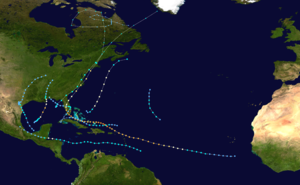
Back Atlantische Hurrikansaison 1960 German Temporada de huracanes en el Atlántico de 1960 Spanish Atlantisch orkaanseizoen 1960 Dutch 1960 Atlantic hurricane season SIMPLE 1960年大西洋飓风季 Chinese
| 1960 Atlantic hurricane season | |
|---|---|
 Season summary map | |
| Seasonal boundaries | |
| First system formed | June 22, 1960 |
| Last system dissipated | September 26, 1960 |
| Strongest storm | |
| Name | Donna |
| • Maximum winds | 145 mph (230 km/h) (1-minute sustained) |
| • Lowest pressure | 930 mbar (hPa; 27.46 inHg) |
| Seasonal statistics | |
| Total depressions | 8 |
| Total storms | 8 |
| Hurricanes | 4 |
| Major hurricanes (Cat. 3+) | 2 |
| Total fatalities | 454 |
| Total damage | $990.74 million (1960 USD) |
| Related articles | |
The 1960 Atlantic hurricane season was the least active season since 1952. The season officially began on June 15,[1] and lasted until November 15.[2] These dates conventionally delimit the period of each year when most tropical cyclones form in the Atlantic basin. The first system, an unnamed storm, developed in the Bay of Campeche on June 22. It brought severe local flooding to southeastern Texas and was considered the worst disaster in some towns since a Hurricane in 1945. The unnamed storm moved across the United States for almost a week before dissipating on June 29. In July, Hurricane Abby resulted in minor damage in the Leeward Islands, before impacting a few Central American counties — the remnants of the storm would go on to form Hurricane Celeste in the East Pacific. Later that month, Tropical Storm Brenda caused flooding across much of the East Coast of the United States. The next storm, Hurricane Cleo, caused no known impact, despite its close proximity to land.
The most significant storm of the season was Hurricane Donna, which at the time was among the ten costliest United States hurricanes. After the precursor caused a deadly plane crash in Senegal, the storm itself brought severe flooding and wind impacts to the Lesser Antilles and Florida, where Donna made landfall as a Category 4 hurricane. It moved northeast and struck North Carolina and Long Island, New York, while still at hurricane intensity. Donna caused at least 428 fatalities and $980 million (1960 USD) in damage. Hurricane Ethel reached Category 3 intensity, but rapidly weakened before making landfall in Mississippi, resulting in only 1 fatality and $1.5 million in losses. The final storm, Florence, developed on September 17. It remained weakened and moved erratically over Cuba and Florida. Only minor flooding was reported. Collectively, the tropical cyclones in 1960 caused at least 454 deaths and about $990.74 million in damage.
- ^ "1960 Hurricane Season Open As Planes Prowl". The Evening Independent. Associated Press. June 15, 1960. p. 1-A. Retrieved January 10, 2013.
- ^ "Hurricane Hunters Go Away Till The Next Time". The Miami News. November 15, 1960. p. 13A. Retrieved February 21, 2020 – via Newspapers.com.
